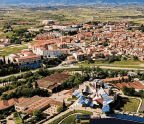
Dreamof Tuscany, Andalucia or Alentejo and you will likely see rolling hills dotted by sculptural olive trees, interspersed with vineyards of gnarly old vines. Olive groves and vines have defined the culture and landscapes of the Mediterranean basin for centuries, inseparable companions across southern Europe and the Middle East. Geopolitics, trade and nature have all played a part in the relationship.
Vines and olive trees thrive in some of the most challenging areas within the 30° and 45° parallels, having adapted to drought and mineral-poor soils where other crops perish. ‘Other trees struggle on the rocky soils in which vines perform best,’ says Adrian Bridge, CEO of The Fladgate Partnership, owner of Quinta de Vargellas, an iconic Douro estate where olive oil is still produced. ‘But olive trees have shallow roots and can survive, for centuries, on inhospitable






